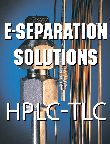Degassing Mobile Phase Solvents
The answers to the following reader questions about degassing mobile phase solvents were supplied by LCGC's "LC Troubleshooting" columnist John Dolan.
The answers to the following reader questions about degassing mobile phase solvents were supplied by LCGC’s “LC Troubleshooting” columnist John Dolan.
In the past (circa 1990), we were trained to degas our mobile phases by sonication under vacuum. The effect was quite spectacular as loads of bubbles would come out of the saturated liquid and then suddenly quit. Later, in-line degassers became the norm and the practice was stopped. I then started to notice that when analyzing low-level impurities and degradation products (near or below the limit of quantification) that there was often significant baseline noise that made it very difficult to integrate these small peaks. This occurred most often when organic and aqueous solutions would be mixed on line. In other words, we let the high performance liquid chromatography (HPLC) system mix them. The HPLC systems were modern instruments with built-in degasser modules that were purported to be sufficient to remove the dissolved gas from the mobile phase components. While troubleshooting the noise issue, the mobile phase components were degassed under vacuum and sonication. The mobile phase components were returned to the HPLC system and the noise was greatly reduced.
Since that time, I’ve made it a discipline to degas my solvents with sonication under vacuum before introducing them to HPLC systems to avoid potential problems. I have been confronted on several occasions about the practice and told that this was a waste of time as the solvents are very quickly (within 30 min) resaturated. I have searched for literature on the saturation rate of degassed liquids, but have been unsuccessful in finding anything useful.
So what is going on?
Are in-line degassers on modern instruments (Waters and Agilent) sufficient to degas HPLC solvents for on-line mixing of gas saturated organic and aqueous solvents?
What about the personal observation of the effect of pre-degassing mobile phase components? Are reproducible data available on the rate of resaturation of air into common HPLC solvents?
John Dolan: Your comments are interesting. There are at least two issues with degassing that are of concern. One is to reduce the air content of the mobile phase sufficiently so that bubbles (outgassing) do not form in the pump and cause pumping problems. The second is to remove dissolved oxygen from the mobile phase.
In terms of degassing effectiveness, refluxing can’t be beat — all the gas is distilled out. But, of course it isn’t very practical. Helium sparging is the gold standard and removes about 80% of the dissolved gas. It addresses both question 1 and 2 above. Vacuum degassing takes out a bit less, maybe 60% of the gas, usually enough for most applications. Sonication alone is not very effective. Common wisdom says that sonication and vacuum together are better than vacuum alone, but I’ve never seen any data on this. In my discussion with the guys who developed the membrane degassers (like Waters and Agilent use), they say that they are equally effective as helium sparging from a practical standpoint of preventing bubbles, but of course they don’t displace oxygen. My contact says that the belt-and-suspenders approach (helium sparge followed by in-line degassing) is what he does for maximum performance. I suppose the membranes could be compromised by contamination (microbial?) so they aren’t as permeable as expected or that there is a vacuum leak so that the degassing is not effective. What happens if you try using the C/D channels instead of A/B for degassing — this might help you track a cause.
How long is sparging effective? I don’t know the uptake rates of gas, but my experience is that off-line sparging is sufficient for some systems (for example, the Shimadzu system in our laboratory works great with once-a-day degassing), whereas others require continuous helium sparging to keep running (for example, the older PerkinElmer systems were this way, I’m not sure about the current generation). Some systems work well with vacuum degassing and some don’t. So it is complicated by equipment performance, too.
I suspect what you are seeing is oxygen in the mobile phase that is showing up at low wavelength and high sensitivity. Some insight might be gained from reference 1. Figure 6.4 of our troubleshooting book (2) shows the effect of replacing a helium sparge with air with UV detection — the baseline shifts. If you had this going on randomly, you could be having problems. Maybe you could do a sub-200-nm experiment to monitor the baseline with different degassing techniques and figure out a bit of the problem.
Also, if you have a copy of my troubleshooting book, there are about a dozen pages on degassing in it with several references. If you do a citation trace on the references, you might be able to pull up something more recent. I have seen nothing on the membrane degassers in the literature and was unable to get any references from my friends in the industry.
References
(1) Sj. van der Wal and L.R. Snyder, J. Chromatogr. 255, 463 (1983).
(2) J.W. Dolan and L.R. Snyder, Troubleshooting LC Systems (Humana Press, Clifton, New Jersey, 1989).
Questions?
LCGC technical editor Steve Brown will answer your technical questions. Each month, one question will be selected to appear in this space, so we welcome your submissions. Please send all questions to the attention of "Ask the Editor" at lcgcedit@lcgcmag.com We look forward to hearing from you.

HPLC 2025 Preview: Fundamentally Speaking (Part 2)
May 14th 2025Michael Lämmerhofer from the Institute of Pharmaceutical Sciences, University of Tübingen, Germany, spoke to JFK Huber Lecture Award winner of 2024 Torgny Fornstedt, professor in analytical chemistry and leader of the Fundamental Separation Science Group, Karlstad University, Sweden, about his pioneering work in high performance liquid chromatography (HPLC) with a focus on fundamentals, ion-pair chromatography, and oligonucleotide applications.

.png&w=3840&q=75)

.png&w=3840&q=75)



.png&w=3840&q=75)



.png&w=3840&q=75)





